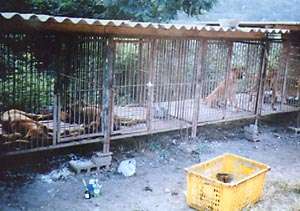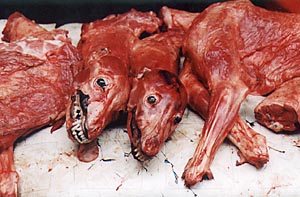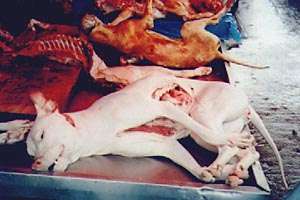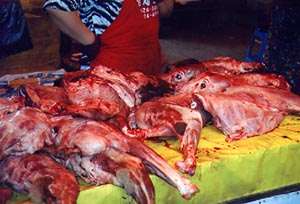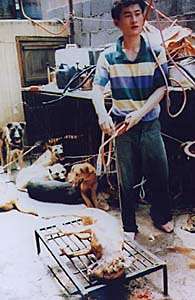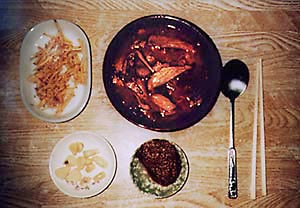

Stop the Torture and Consumption of Dogs in Korea
Take Action: Every year, about two million dogs suffer this fate in Korea.
This is a typical (and highly illegal) dog farm in a Korean countryside. In the city, people raise dogs in smaller numbers, nearly as pets, and then sell them to dog meat traders. It is easy to deceive the dogs and gain their trust, only to betray them in the end.This photo was obtained with hidden camera.
Although on paper these dog farms are illegal, the government is doing nothing to enforce their laws. Some traders raise a few dogs at a time and can sell them all in a day at the market. The prevalence of these small backyard operations is difficult to determine. There are usually a few residents in every neighborhood who raise dogs or steal or poison other people’s pets in order to make a profit.
Someone’s stolen or abandoned Saint Bernard stands alone among the cages stuffed with dogs. The animal show signs of neglect. This is Moran Market in Sungnam City. It boasts the largest dog market in Korea. There are days of the week that are considered “dog days,” when you can experience the true scope of this illegal trade. This photo was taken with hidden camera. Since the 1988 Seoul Olympics, word has spread that international animal welfare groups are campaigning against this industry, and dog meat dealers have become hostile to those who disapprove. In fact, you will now find plain-clothed guards posted at the markets to prevent foreigners from approaching.
Someone’s stolen or abandoned Saint Bernard stands alone among the cages stuffed with dogs. The animal show signs of neglect. This is Moran Market in Sungnam City. It boasts the largest dog market in Korea. There are days of the week that are considered “dog days,” when you can experience the true scope of this illegal trade. This photo was taken with hidden camera. Since the 1988 Seoul Olympics, word has spread that international animal welfare groups are campaigning against this industry, and dog meat dealers have become hostile to those who disapprove. In fact, you will now find plain-clothed guards posted at the markets to prevent foreigners from approaching.
Dog traders typically transport animals by truck from dog farms to city markets. Note the sign above the truck. It advertises cats for sale. However, these are not pet cats. These are cats that will be slaughtered and “prepared” in large pressure cookers to create an elixir that supposedly cures rheumatism.Large yellow-colored dogs are considered best for eating.The chindo (or jindo) is a designated national treasure, which is protected by law (as are all other dogs) and are not eaten. While Koreans are quite proud of the chindo, in truth, they will eat any dog regardless of pedigree.
This dog is definitely not the yellowish dog that Koreans claim to prefer. In fact, it doesn’t resemble any of the dogs typically raised for meat. We conclude that this dog is another unfortunate pet that was either abandoned or stolen. It neither cowered nor retreated when approached. We asked supporters to help us identify this breed and several wrote to say that this dog is a purebred Pointer.Here is further evidence of pets being sold as food. There appears to be a pug in this cage (to the right) and it is still wearing its collar. It was coaxed out of the cage, its skull was crushed and then its fur torched off. This is standard procedure, though Korean officials will adamantly deny that pedigree animals are ever eaten
.Once the dog is selected, it is dragged reluctantly away to its death. These animals are not stupid. They can sense danger and live with death all around them. Koreans believe that dogs that die painfully will release more adrenaline into their flesh, creating a more potent and flavorful meat. This accounts for the savagely cruel methods of slaughtering.
When the choice is made and the transaction finished, the dog is slaughtered on the spot: the dog’s neck is held and his head is hit with a metal stick. After the concussion, an electric stick is then used to complete the killing. This happens to dogs (in the market) all day long.
The slaughtered dogs are brought to the processing factory by motorcycle.
One couple selects a dog. A rope is put around the dog’s neck and he is dragged out of the cage. This time, electrocution is used right away. The dog screams and then becomes stiff. The rope is take off the dog and he is given the electric shock one more time. Then another dog is killed by the same method.
Dogs in cages watch as their companions are killed and prepared to be eaten.
In most markets, there are plain-clothed guards to keep foreigners at a distance.
If Koreans are so proud of their dog-eating tradition, why do the butchers hide from cameras, why did the government make it illegal, and why would they even care what foreigners think about it?
What about the millions of domestic animals suffering behind these facilities in the backs of marketplaces being hung, electrocuted,tortured, beaten, boiled alive, skinned alive, suffocated, gutted, blowtorched and burnt to a crisp?
They think Dog skins and dogheads are a delicacy.













